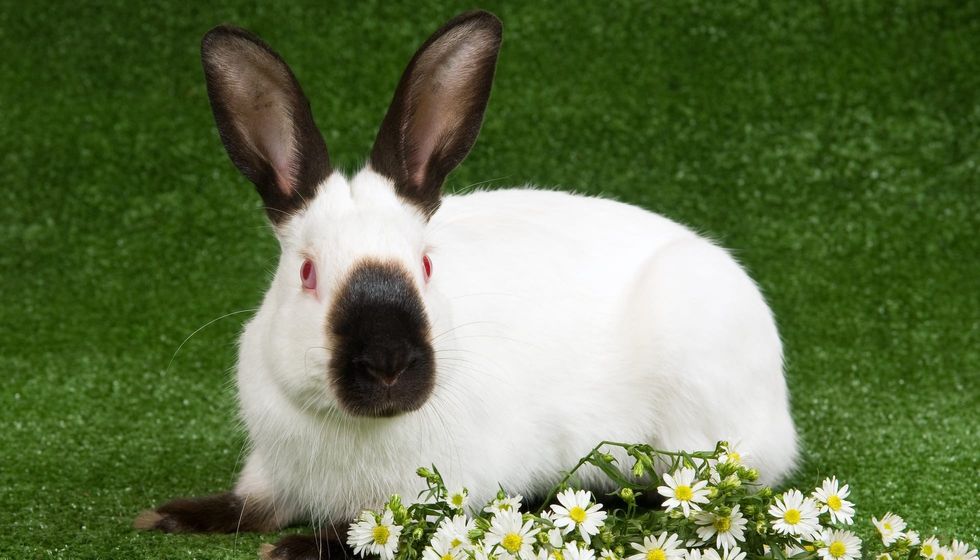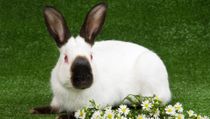If you want your child to know about the rare cylindrical breed of rabbits, introduce them to the Himalayan rabbits!
The Himalayan rabbit is one of the oldest breeds of rabbits. Though the name has Himalayan in it, it is not clear whether these rabbits are really from the Himalayas or not. This rabbit breed is the ancestor of the Californian rabbits.
The Californian rabbits have been obtained as a result of crossbreeding with other types of rabbits. The Himalayan rabbit breed is thinner and is not raised for meat. This rabbit breed mainly serves the purpose of the show.
The place of origin of these rabbits is traced to Asia, the Middle East, or the Far East. However, there is a debate on its place of origin. The Himalayan rabbit is known by different names across the world.
It also goes by the names black-nose rabbit, the Chinese rabbit, the Eqyptian rabbit, or the Russian rabbit. In the United States, they are also called Himmies! Isn't that cute?
Like reading about this furry animal and want to know more? Let's move on!
If you like reading about this animal, you may also like reading about white-tailed jackrabbit facts and mini satin rabbit facts.
Himalayan Rabbit Interesting Facts
What type of animal is a Himalayan rabbit?
The Himalayan rabbit is an animal of kingdom Animalia, phylum Chordata, class Mammalia, order Lagomorpha, family Leporidae, genus Oryctolagus, and species cuniculus. The scientific name of this rabbit is Oryctolagus cuniculus Himalayan.
What class of animal does a Himalayan rabbit belong to?
The calm Himalayan rabbit belongs to the class Mammalia, that is, it is a mammal.
How many Himalayan rabbits are there in the world?
The pure Himalayan rabbits may be rare. However, the various crossbreeds are abundant in number.
Where does a Himalayan rabbit live?
Himalayan rabbits are found in a house. The Himalayan rabbit is essentially a domestic breed of soft, white rabbits with black markings.
What is a Himalayan rabbit's habitat?
Himalayan rabbits are found all around the world in homes as domestic pets. The Himalayan rabbit's habitat is a house. The Himalayan rabbit is well suited to cold temperatures. The Himalayans are found in Asia, Middle East, Far East, and North America.
Who do Himalayan rabbits live with?
The calm Himalayan rabbits can live with people as pets.
How long does a Himalayan rabbit live?
The calm Himalayan rabbit may live seven to ten years. They live for a minimum of five years usually.
How do they reproduce?
When the soft-sized, small female is pregnant, she is said to be 'in kindle'! The gestation period for these rabbit breeds is 31 days. The furry coat and markings grow on the kitten after 10 days of birth. The rabbit's kitten is born blind with ears and nose.
The breed is hairless at birth. The litter size of these rabbit breeds ranges between six and seven. However, the litter size can grow up to 12.
A female rabbit may deliver five litters in a year. Clearly, these rabbit breeds can reproduce fast as is common with other rabbit breeds. The kittens are weaned for up to four weeks. Initially, the doe's milk is the diet for the kitten.
What is their conservation status?
Though the Himalayan is one of the oldest breeds of rabbit, they are not assessed under the International Conservation of Nature (IUCN).
Himalayan Rabbit Fun Facts
What do Himalayan rabbits look like?

A white-colored coat with a black nose and ears. There are similar dark-colored markings on the tail and feet of the Himalayan rabbit. The baby Himalayans develop their fur as they grow.
The Himalayan rabbit's coat color may develop a yellowish tinge when they are inhabitants of warm climates. The body type is small in size and is covered in soft short fur.
The feet have claws. They have large upright ears. The ears can turn in all directions to trace sounds.
Their eyes are on the sides of their head. This feature helps them to locate predators from all sides. Rabbits have two sets of upper incisors.
The second set of teeth is called peg teeth and is directly behind the first. The peg teeth are smaller than the first set of incisors. The teeth of a rabbit grow throughout its entire life.
That is the reason why they tend to chew things. Chewing helps them to control the growth and development of the teeth.
A diet high in hay can help improve this situation. When exposed to cold weather they may form additional markings around the eyes called 'smut' and around the genitals called 'vent smut'. If the weather is warm it may add white hairs to the markings called frosting.
How cute are they?
Himalayan rabbits are very cute animals!
How do they communicate?
This rabbit uses its fur color to communicate fitness in the breeding season.
How big is a Himalayan rabbit?
The rabbit is smaller as compared to other breeds of rabbits. Only dwarf rabbits are smaller than Himalayan rabbits.
How fast can a Himalayan rabbit run?
The rabbits are excellent runners. Their running speed helps them to deter predators. Their strong hind legs help in running.
How much does a Himalayan rabbit weigh?
The Himalayan rabbit weighs an average of between 2.5-4.5 lb (1-2 kg). The ideal weight is around 3.5 lb (1.5 Kg).
What are the male and female names of the species?
The male rabbits are called bucks and the female rabbits are called does.
What would you call a baby Himalayan rabbit?
Baby rabbits are called kittens or kits.
What do they eat?
The rabbits are herbivores. The diet includes rabbit pellets, hay, fruits, and vegetables.
Are they dangerous?
These rabbits have a gentle temperament, though occasionally they may bite. They do not exhibit violent behavior towards humans in general. They do not show dangerous behavior and are perfectly docile.
Would they make a good pet?
The rabbits are excellent as pets because of their temperament. They are very friendly with humans and are known to have a calm temperament and are intelligent.
They are very good in behavior when kept around young children and elderly people. They are good companions for young children to play with.
When kept as pets, baby rabbits should not be exposed to freezing temperatures. Although this rabbit breed needs minimum grooming, it does need daily exercise in order to maintain its health.
They are always in search of something to chew and hence should be kept protected in a cage. Pets are fed diced fruits and vegetables.
They are fast eaters hence the owners should keep a check on the number of fruits and vegetables their pets eat to keep their weight in check. A healthy dose of sunshine is a requirement.
They need to be taken out of their enclosures so they can connect with other family members and absorb some vitamin D. They are not that active, unlike other energized rabbits.
These Himalayans generally do not have health problems. Certain health problems like with their teeth may arise.
Mites may be a problem sometimes. They can develop a condition called flystrike when flies infest the rabbit's body and lay eggs on it.
This condition can be extremely painful for the pet as if left unattended, the flies may start to feed upon the rabbit's body and flesh and can prove to be fatal. Hence, occasional appointments with vets are a good option for your rabbit's good health.
Did you know...
The rabbits were brought to North America in the early 1900s from England. The fur of the Himalayan rabbit was known as the Ermine fur of rabbits.
They are the only rabbits to have an extra set of nipples.
The European Himalayans and the American Himalayans do not have the same pose.
The tail of a rabbit is called a 'scut' (pronounced 'scoot').
The Himalayan rabbits are often compared to cats. This is because they are sharp like cats and can recognize their names. Also, they enjoy being petted. Just like cats, they enjoy sitting in their owner's laps.
The Himalayan rabbits love to play with rabbit toys. However, they are more difficult to train in comparison to dogs and cats. Luckily though, they can be trained to use a litter box!
The price of a Himalayan rabbit ranges between $15 to $30. The Himalayan rabbits have red eyes due to albinism. However, a pure breed of Himalayan rabbit with a white coat will have pink irises.
The Himalayan rabbit is one of the most widely distributed rabbit breeds in the world.
In the early 1900s, the Himalayan fur was the best rabbit fur. The Himalayan rabbit is assumed to have descended from silver rabbits.
The American chocolate Himalayan was made by Ron smelt of California by intermixing the chocolate English spots with the Himalayans. The Californian rabbits look like the Himalayans.
However, they have more flesh on their bodies and are raised for meat. That is, they are one of the most popular commercial types of rabbits. Some other rabbit breeds include the swamp rabbit, the European rabbit, and the Rhinelander rabbit.
Do Himalayan rabbits change color?
The Himalayan rabbits change color like turning black depending on the temperature. The lower the temperature, the darker is the fur. The gene expression for fur color is influenced by temperature in this rabbit breed.
Gene C controls the pigmentation in the rabbit. The gene is inactive above 95 F (35 C). It is most active between fifteen and twenty degrees.
The black, blue, chocolate, or blue chocolate and lilac breeds were obtained by intermixing. The black Himalayan came early followed by the blue Himalayans.
The black and chocolate Himalayans have a full saturation. The blue and the lilac are dilute versions. The rabbit has a double copy of the ch gene as well as a mutated gene for albinism.
When interbreeding, the black color is the most dominant followed by the blue and chocolate. The lilac is the rarest of them all. Humans need to be careful about the specific expression of color that they want.
Black color has a dominant trait. Blue and chocolate have one dominant trait and one recessive trait. The lilac is the rarest with two recessive traits.
Why do Himalayan rabbits turn black?
The Himalayan rabbit has a heat-sensitive enzyme in its body. This enzyme produces a brown pigment called melanin and is active in the discolored parts of the rabbit's fur.
The Himalayan rabbits turn black blue chocolate or blue chocolate and lilac due to interbreeding. The ears and feet being colder as compared to the rest of the body are black in color.
In an experiment when the fur was shaved and an ice pack was placed on the back of a rabbit, the fur that grew in that place was black in color. What an interesting phenomenon!
Here at Kidadl, we have carefully created lots of interesting family-friendly animal facts for everyone to discover! Learn more about some other mammals including black bear hamster facts and Diana monkey facts.
You can even occupy yourself at home by coloring in one of our free printable Himalayan rabbit coloring pages.










